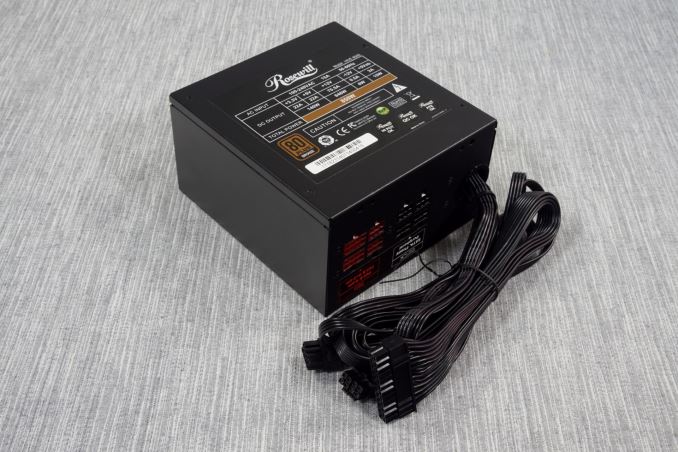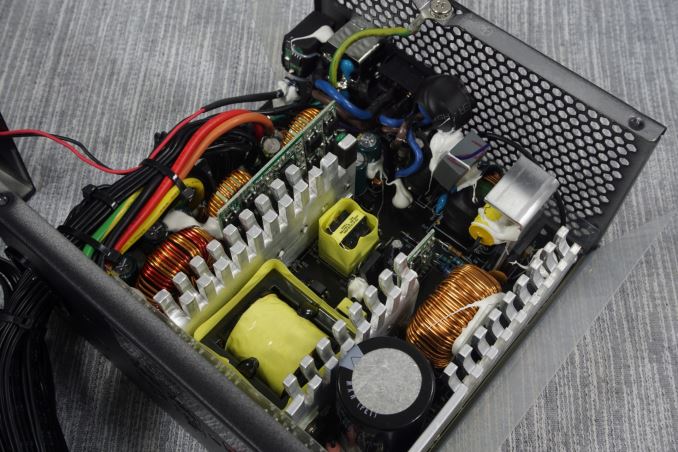The Rosewill Hive 850W PSU Review
by E. Fylladitakis on July 28, 2015 9:00 AM EST- Posted in
- PSUs
- Cases/Cooling/PSUs
- Rosewill
- 850W
Conclusion
Bringing our review of the Hive 850W to a close, perhaps the best jumping-off point is to start with the underlying platform itself, the Direct12 Bronze v.2.
Overall the platform the Hive 850W is based on is not bad, just somewhat outdated. Sirfa designed the Direct12 Bronze v.2 platform a couple of years ago, to compete with other 80Plus Bronze certified products at a time when technologies that are more efficient were very costly. This is why the PSU implements technologies that are normally reserved for higher performance units, such as DC-to-DC conversion circuitry. They were inserted in order to provide a performance edge over other platforms available at the time without creating a very expensive product. At the same time, the inversion/conversion circuits are using active components that are not very efficient. Their high energy losses generate significant amounts of heat, with that heat further decreasing their efficiency, creating a cascading effect when the PSU is heavily loaded.
We cannot complain at all about the quality of the Hive 850W PSU. It is not the best that it could be, but it is very good and certainly on par with other similarly priced products. The OEM is reputable, the components are of very good quality and the assembly job is excellent. What the Hive 850W could use is better heatsinks, but that is a design/performance issue, not a sign of bad quality. It does work fine with its current heatsinks, but the brunt of the cooling requirements falls on the fan, forcing it to spin very fast and becomes very loud if the Hive is under very heavy load or installed in harsh ambient conditions. The Hive generally is quiet when lightly loaded, as the fan does not have to work as hard to dissipate the heat. As such, the Hive 850W displays troubling thermal behavior and mediocre acoustics performance.
As for its electrical performance, it is good but uninspiring by today's standards. We recorded very low voltage ripple levels and found the output power quality of the Hive to be very good, even considering the higher ripple that we saw with the unit heavily cross-loaded. The regulation of the voltage lines could be improved, as it is acceptable but not really good for a high performance PSU. Finally, the electrical conversion efficiency is obviously not competitive against the newer, more advanced platforms available today, but it is good for an 80Plus Bronze certified unit and meets the performance levels it is supposed to.
Rosewill designed the Hive 850W mainly to lure mainstream users and enthusiasts on a tight budget. The primary purpose of this PSU is to entice via its good value. As such, it is not a top performer, as it was never meant to be. However, the retail price of $100 including shipping is not particularly cheap, even for an 850W PSU. Considering that the target group of the Hive 850W PSU is enthusiasts with rather powerful gaming or professional systems - users that often don't mind spending a little extra for a high quality product - it will be very hard for Rosewill to convince them that the Hive 850W is the right choice for them. On the other hand, if someone is on a very tight budget, other companies are lurking with equally well-made products at even lower prices. At the time of this review, EVGA is offering the SuperNova 850 B2 for $90 incl. shipping and 800W LEPA MaxBron similarly retails for $90 incl. shipping. If the retail price of the Hive 850W were to drop a little, it could compete in terms of value with the rest of the 800-900 Watt PSUs. Otherwise in terms of overall performance, it may not generally be a bad performer, but it does not really stand a chance against the more advanced platforms available today.












24 Comments
View All Comments
ImSpartacus - Tuesday, July 28, 2015 - link
As a layman, this was a cool review to read. It's often hard to figure out exactly what makes one psu different from another with similar marketing "specs". It's assumed that many are based on a handful of oem's designs, but it can be a challenge to dig that deep. This review presents much of that info up front. No digging necessary. Cool beans.Stuka87 - Tuesday, July 28, 2015 - link
The 12V rail sag is a bit more than I would like. And the fact that its only rated for 40C is really a bummer. Its very common for the inside of a PC case to hit 45-50C, especially in the summer with a few GPU's inside it. Some cases do let you put the PUS in upside down so it sucks in cool air (my own does) but many do not.MamiyaOtaru - Wednesday, July 29, 2015 - link
cases that don't put the PSU at the bottom are an anachronism IMHOAndrewJacksonZA - Tuesday, July 28, 2015 - link
Were these tests done at 110V or 220V?E.Fyll - Tuesday, July 28, 2015 - link
230V/50Hz. It is noted in the pipeline that includes the details of all the equipment and procedures.piasabird - Tuesday, July 28, 2015 - link
How do you know what this means unless you have a few other power supplies as a baseline to draw a comparison. For instance if you had what you considered is the best test results for a power supply, and one or two other the test results might make more sense. You always show comparisons for processors and video cards.Oxford Guy - Wednesday, July 29, 2015 - link
An entire article just for one PSU?doggface - Wednesday, July 29, 2015 - link
Have you been here before. They do this all the time???Oxford Guy - Wednesday, July 29, 2015 - link
It's one thing for a little site to devote an entire article to a bronze PSU and another thing for a big one to do so.Quake - Monday, August 3, 2015 - link
Eh... Anandtech was founded in 1997 and it's one of the biggest enthusiast website. https://en.m.wikipedia.org/wiki/AnandTech